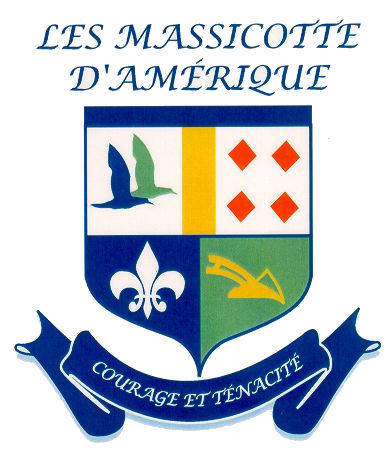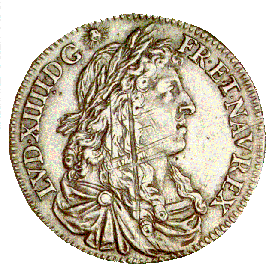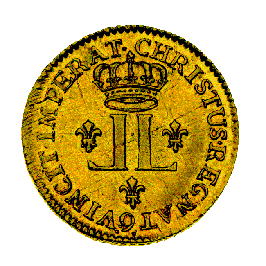
Money during Jacques Life
The
colonists living in New France from the mid-1660s on used barter to
exchange goods but also used metal coins, such as this 15-sol French
coin dated 1670. However, there was never enough hard currency to go
around. Silver coins that were sent from France were quickly taken from
circulation by local merchants, who immediately returned them to France
to pay their taxes and to buy European-made commodities.
The
shortage of coins persisted
throughout the history of New France. As a substitute, the inhabitants
of New France sometimes used the Spanish-American silver coins minted
by the Spanish in Mexico and South America. Although they were banned
by the French government to discourage trade with the enemy, this coin
circulated widely in New France.
 The
first coins issued for use in what was later to become Canada were minted
over 300 years ago, or nearly 200 years before Confederation. In the
early days of New France, the need for a local currency was partially
met by the use of ordinary French coins. In 1670, Louis XIV was prevailed
upon to issue a special coinage for use in the French colonies of North
America. Silver coins in the denominations of 5 sols and 15 sols were
struck, as well as a 2-deniers piece in copper. The 15-sol piece, illustrated,
was slightly larger than a Canadian 25-cent piece and was worth a little
more than an English shilling of that day. The Latin inscription refers
to Louis XIV, whose bust appears on the front of the coin: "They shall
speak of thy glory of thy kingdom.'' The letter 'A' at the bottom of
the inscription is the mint mark of the Paris Mint. These coins are
now very rare.
The
first coins issued for use in what was later to become Canada were minted
over 300 years ago, or nearly 200 years before Confederation. In the
early days of New France, the need for a local currency was partially
met by the use of ordinary French coins. In 1670, Louis XIV was prevailed
upon to issue a special coinage for use in the French colonies of North
America. Silver coins in the denominations of 5 sols and 15 sols were
struck, as well as a 2-deniers piece in copper. The 15-sol piece, illustrated,
was slightly larger than a Canadian 25-cent piece and was worth a little
more than an English shilling of that day. The Latin inscription refers
to Louis XIV, whose bust appears on the front of the coin: "They shall
speak of thy glory of thy kingdom.'' The letter 'A' at the bottom of
the inscription is the mint mark of the Paris Mint. These coins are
now very rare.
In
the late 17th century, the shortage of coinage grew so severe that New
France's colonial authorities resorted to issuing a completely new kind
of money: playing cards. In 1685, the government had no money to pay
the wages of soldiers stationed at Quebec. Intendant De Meulles had
the ingenious idea of taking ordinary playing cards and writing an amount
on the back. The cards were given to the soldiers, who accepted them
as legal tender and began to use them in their transactions. The following
year, 1686, the cards were exchanged for coins of the realm sent by
boat from France. The experiment was such a success that, despite the
misgivings of the King of France, who felt the colony ran the risk of
incurring substantially higher costs, playing card money continued to
be issued on a more or less regular basis.
The photo is a reproduction. No examples of playing card money are known to have survived.
By
1720, the King of France decided to ban the practice of issuing playing
card money. The colony's inhabitants were forced to make do with coinage
supplied from France, such as the 30-deniers coin known as a "mousquetaire"
because its cross resembled that adorning the capes of the famous musketeers.
The gold coins, which were intended primarily to pay the troops and
other civil servants, did not remain in the colony for long.
La
Compagnie des Indes Occidentales, which held a monopoly over the fur
trade in New France, also issued coins for use in the colony. But as
the coins were not legal tender in France, local merchants refused to
accept them. Consequently, the shortage of coinage remained a major
problem in the early part of the 18th century. By the first quarter
of the 18th century, costly and unsuccessful wars had brought France
almost to the brink of bankruptcy, and the economic strain was reflected
in both the metallic and paper currencies. Most coins issued at this
time bore no indication of denomination, leaving it to the authorities
to proclaim the rate at which each was to be current. Thus, in an effort
to gain much-needed revenue, France attempted to make large profits
from her coinage by issuing coins at inflated ratings. However, to avoid
strong public resistance, these ratings would gradually be lowered to
more acceptable levels. Periodically, as the rating of a particular
coin approached a more realistic value and the issue became less profitable,
the cycle was begun again with a coin of a new design.
 It
is not difficult to imagine the chaos this practice created. A specific
example of such coinage manipulation can be seen in the gold louis issued
from l720 to l723. The initial official rating of this coin in 1720
was 54 livres, but by the time the coin was called in and replaced with
a new design in 1723 the rating had been lowered to 39 livres, 12 sols.
Slightly larger than a Canadian 25-cent piece, the louis d'or features
a crown over two Ls,
It
is not difficult to imagine the chaos this practice created. A specific
example of such coinage manipulation can be seen in the gold louis issued
from l720 to l723. The initial official rating of this coin in 1720
was 54 livres, but by the time the coin was called in and replaced with
a new design in 1723 the rating had been lowered to 39 livres, 12 sols.
Slightly larger than a Canadian 25-cent piece, the louis d'or features
a crown over two Ls, which
are back to back. Three fleurs-de-lys adorn the field. The number "9"
at the bottom of the piece represents the mint at Rennes and the Latin
legend "CHRISTUS REGNAT VINCIT IMPERAT" translates to "Christ reigns,
conquers and commands." Sometimes referred to as the "John Law" louis
because it was first issued under the authority of John Law, a Scottish
banker who became the main financial adviser to Louis XV, the l720-23
louis circulated to a limited extent in New France, the principal French
colony in North America. The value of the paper and metallic currencies
of the time reflected the state of the economy.
In
response to the currency shortage, the King of France authorized a new
issue of card money in 1729. Card money was issued until the fall of
New France in 1760. Unlike that issued from 1685 to 1714, this card
money was printed on ordinary white cardboard, and the size varied by
denomination. From 1720 until the beginning of the British colonial
period in 1760, other forms of paper money also circulated in New France.
Treasury bills (ordonnances) and Letters of Exchange, for example, became
so popular that they soon exceeded the quantity of card money in circulation.
With the defeat of France in 1760, this mass of paper money was redeemed
at only a fraction of its face value. Most people in Lower Canada lost
confidence in paper money and began to hoard coinage in the proverbial
sock.
All information on this page is from the Canadian Currency Museum.
Last
Updated
May 19th, 2002